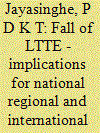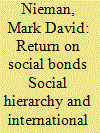| Srl | Item |
| 1 |
ID:
131231


|
|
|
| 2 |
ID:
133509


|
|
|
|
|
| Publication |
2014.
|
| Summary/Abstract |
This article seeks to determine the mechanism(s) behind the convergence of domestic counterterrorism regulations that has been noted across many Organisation for Economic Co-operation and Development (OECD) countries. Four hypotheses are developed and tested through regression analyses. These hypotheses examine (1) U.S. influence, operationalized though a unique U.S. footprint indicator; (2) national characteristics; (3) the extent to which states' domestic structures match; and (4) international networks. We find little support that U.S. influence matters. The international influence that does exist seems to operate through networks promoting learning, especially following a rise in the general global threat level. National characteristics as a driver also find some support.
|
|
|
|
|
|
|
|
|
|
|
|
|
|
|
|
| 3 |
ID:
147835


|
|
|
|
|
| Summary/Abstract |
This article takes a game-theoretic and latent variable approach to modeling the effect of international social hierarchies on conflict among states. I start with the premise that international states are social actors and are nested within informal social networks of friendly and conflictual relationships. Rather than lateral relationships among equals, networks among states tend to have a vertical or hierarchical structure. Although international hierarchical relationships may arise as a result of material power asymmetries, this article focuses on non-material asymmetries that stem from political legitimacy or policy innovation – a subject that has received less attention in scholarly research. I argue that, within these hierarchies, states adopt one of two roles – a dominant or a subordinate. Each resulting (dyadic) dominant–subordinate relationship is a social contract, in which the subordinate concedes some autonomy in exchange for the dominant’s protection. This social hierarchy affects the relationships among subordinates, as well as between a dominant and subordinates. The model predicts that a state’s degree of subordination reduces its probability of conflict initiation against other subordinates. Moreover, the decision to initiate conflict is influenced by the expectation that the dominant will intervene, which itself is affected by the target’s relative level of subordination to the dominant vis-à-vis the challenger. These predictions are supported by empirical analyses of the US hierarchy (1950–2000).
|
|
|
|
|
|
|
|
|
|
|
|
|
|
|
|